The Microsoft Surface Pro (2017) Review: Evolution
by Brett Howse on June 15, 2017 9:00 AM ESTGraphics Performance
With the Core i7-7660U, we finally get a chance to look at the Intel Iris Plus Graphics 640 in a notebook. On a typical U series Intel Core processor, there are 24 execution units (EUs) available, but the Iris Plus doubles that to 48. Despite having the same TDP, having twice as many EUs running should still be a big boost to performance, as even if they need to throttle, there are twice as many, so they can run slow and wide and still fit in the TDP. The base frequency for the graphics is 300 MHz, with a 1.1 GHz boost frequency.
The addition of 64 MB of eDRAM is also a large benefit to graphics, which needs a lot more memory bandwidth than the CPU, and having this extra eDRAM as a cache for the GPU is a big benefit to the Iris Plus graphics.
In the graphs below, make note that the Dell XPS 15 has a GTX 960M graphics card, which should win pretty handily, but the Surface Book has a smaller GT 940M with 2 GB of GDDR5, so it will be interesting to see the performance difference between the integrated Iris Plus Graphics 640, and a discrete entry-level GPU.
3DMark
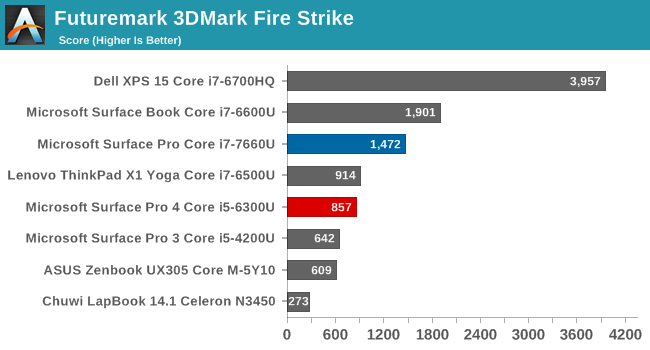
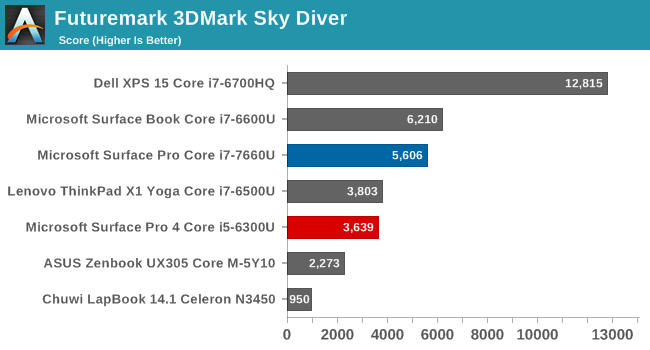


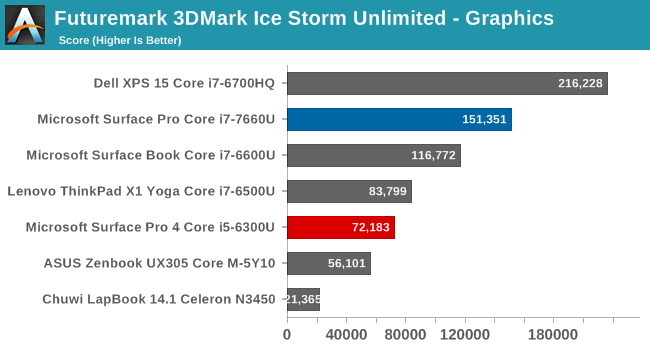
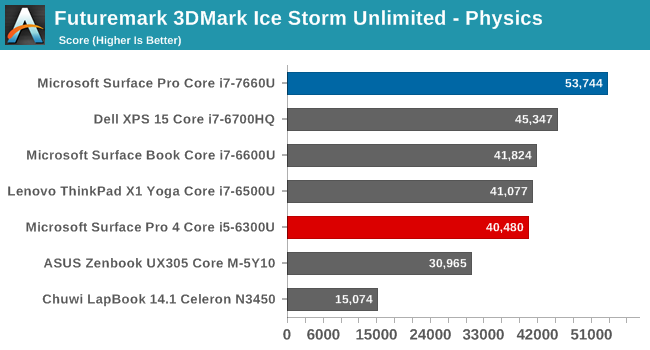
Futuremark’s 3DMark continues to be developed, and new tests have been added for higher end systems, but for our purposes on this review, the normal results will do just fine. Each of the tests move from quality to performance, with Fire Strike being the most demanding, and Ice Storm Unlimited being a smartphone or tablet test. The GT 940M in the Surface Book still manages to hold an edge on the more graphically demanding tests, but is then surpassed as the workload gets easier, and the test becomes more CPU bound. Compared to the non-Iris Ultrabooks though, the i7-7660U delivers a lot more performance.
GFXBench
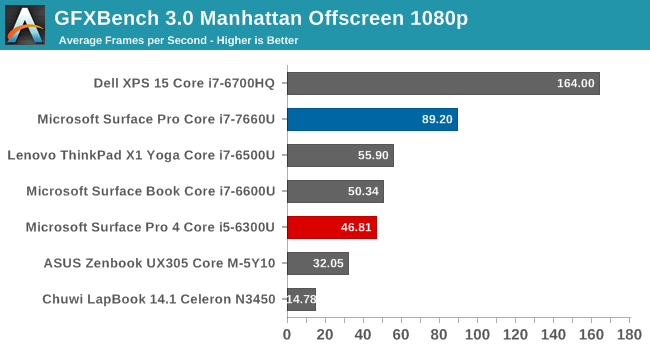

Another synthetic, Kishonti’s GFXBench also continues to evolve, with new tests being added to provide more stressful tests than the older T-Rex and Manhattan ones. Since we don’t have any comparison data, for now we’ll stick with the older tests while we fill out the data gaps. The Intel Iris graphics pull out a hefty lead here.
Dota 2
Valve’s Dota 2 online area game continues to be our go-to game for testing systems with lower end graphics, since it has a low barrier of entry, and is quite playable at low settings even on a system with integrated graphics.
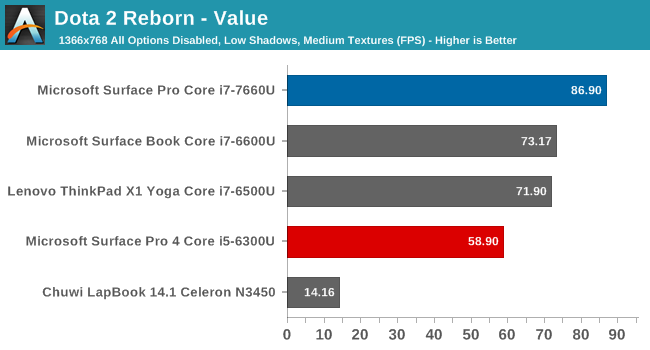
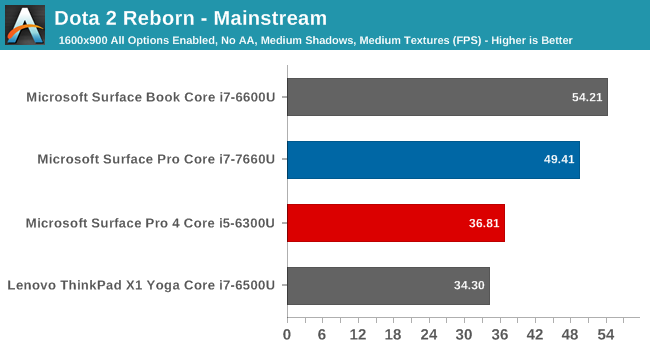

Here the Iris Plus Graphics do not bring the kind of improvement that would have been hoped for. At lower settings, they are very capable, and the extra CPU speed from the i7-7660U helps break the CPU bound barrier of the other systems, but once the graphics are turned up, the U series chip runs into the thermal barrier of only having a 15-Watt TDP. Compared to the Microsoft Surface Book, with it’s discrete GT 940M GPU, there’s really no contest, since that GPU alone would have 20-30 Watts of TDP available to it. The Iris does allow a lot more graphics potential, but for longer duration requirements, it may not offer much of an upgrade.
Graphics Conclusion
It’s great to finally be able to test a system with a U Series CPU and Iris graphics, and the results are quite impressive. It’s not quite up to par with even a low-end discrete GPU, but compared to the other integrated GPUs available in the other Ultrabooks, the Iris really brings the performance up a step. For light gaming, it should work well, but the extra eDRAM can help out on practically any task. The extra EUs available would also be of benefit to any productivity app that can leverage the GPU for some of its compute.
Storage Performance
PCIe SSDs have been the name of the game for the last couple of generations of Ultrabooks, but they’ve generally been shipping in the M.2 form factor. Microsoft has gone a different route with the new Surface Pro, by moving to a much smaller BGA SSD in the Samsung PM971.
The benefits of going this route are mostly packaging. The BGA SSD is significantly smaller than any M.2 SSD, especially the 2280 versions that are the most common. The drive is also most likely more energy efficient than the fastest SSDs available today, which should help with battery life.
There is likely only one downside to the PM971 BGA SSD, and that is performance. While still much faster than a SATA SSD, the PM971 is limited to a PCIe 3.0 x2 link, which is going to impact the maximum read and write speeds.
As you can see in the CrystalDiskMark test, the maximum read speed is well under something like a Samsung SM961. This may seem like bad news, but in fact the PM971 actually outperforms the same size PM951 drive which was easily the most popular SSD found in Ultrabooks until recently. The PM971 is 48 layer TLC NAND, with reasonable write speeds, and other than the lowered maximums created by the PCIe link being x2 instead of x4, the performance is quite good.
When you look at a device like the Surface Pro, where space is at a premium, these are the kinds of compromises that make sense when you consider that they’ve increased the battery capacity by 15%, and despite going with a compact SSD, they’ve still increased performance over the outgoing model assuming it had a PM951, which it seemed most did.











124 Comments
View All Comments
serendip - Thursday, June 15, 2017 - link
Microsoft sells a tiny foldable Bluetooth keyboard with an Alcantara covering. I've been using it for months and it still looks good. It's a lot easier to unfold the keyboard when I need it and I can use the tablet without an attached keyboard in tablet mode. These cover-type keyboards add extra weight and make the tablet hard to use as a tablet.SaolDan - Friday, June 16, 2017 - link
I own a SP4 for personal use and a Huawei matebook for work. Let me tell you that you get used to the keyboard cover and stand theres no going back. i wish my company would give me a sp4 or the new one instead of the matebook. matebook can keep the type c. Type c is very nice but not that necessary for work.simard57 - Wednesday, June 21, 2017 - link
how would you compare the Matebook to the SP4?simard57 - Wednesday, June 21, 2017 - link
my past buying habits were mid level laptops - not top of the line ultrabooks - and the hinge is the Achilles heel of them. plastic and metal hinges are not made for a long marriage. the old adage, you pay for what you get, surely does applytipoo - Thursday, June 15, 2017 - link
Not everyone uses the same coatings on it. Microsoft has shipped alcantara Surface keyboards for years and they hold up well on average. The iPad Pros Apple fabric keyboard, whatever that fabric is, wears more in weeks, Microsofts is still the best fabric tabletey keyboard solution.
BillBear - Thursday, June 15, 2017 - link
If a spray on coating could make the Alcantara covered steering wheels on a Porsche hold up to wear, they would most assuredly already be using it.However, if you check out the video above you'll see that this is simply not the case.
mkozakewich - Saturday, June 17, 2017 - link
If you're talking about that video they posted on Reddit, someone else said the 'wear' is actually just grime that can be washed off.Everyone clings so hard to the marketing material. If the original Type Cover wasn't Alcantara, it was at least something very similar. It had a wonderful feel and withstood the years well. It washed well, too, and looks great even today. I could never stand the weird felt-like stuff they've been using the last few years.
Manch - Saturday, June 17, 2017 - link
My original Surface Pro KB is just fine. The track pad has bit of visible wear but other than that, its still nice. BillBear has been going on and on about the damn Alcantara but you can get a keyboard without it so I don't understand the grief. Anncedotal evidence of Porsche steering wheels, doesnt prove anything. The material is used on all kinds of things with no issues.Brett Howse - Thursday, June 15, 2017 - link
Only time will tell if the polyurethane coating on the Surface Signature Type Cover holds up well, but I've been using the Surface Ergonomic Keyboard on my desk for over six months now, and the Alcantara still looks almost new. YMMV, of course, but the normal Surface Type Cover can get beat up too. I don't see this as the major downside of others. At worst, it's going to be about the same as what we've already got.Manch - Saturday, June 17, 2017 - link
Or you could buy the regular type cover with or without the fingerprint sensor instead of the Alcantara